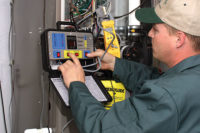Several years ago, I attended an outstanding seminar on system evacuation where the presenter, a “guru” of evacuation, used a phrase that stuck with me. He said all refrigeration technicians, while working on a system, should strive to make sure the system is clean, dry, and tight. If you remember these three simple words, you will ensure the system works as it was intended and prevent its premature failure.
Keeping a system clean, dry, and tight really comes down to service technicians and how they handle installing or servicing a system. Let’s discuss some basic installation and service procedures that will ensure we always leave a system clean, dry, and tight.
Keeping a system clean really comes down to the proper handling of refrigerant components, tubing, and refrigeration hoses. When installing and storing refrigeration components and tubing, always keep the ends sealed. Working with open ends can introduce all types of contaminants into the component or tubing. Only unseal the ends when you are ready to connect them to a section of tubing or a system component. When storing components and tubing, always reseal the ends to prevent unknown contaminants from entering.
The same is true for your refrigeration hoses, always keep them capped when not in use. Sometimes you will see a technician dragging hoses on the ground uncapped or allowing the ends of hoses to drop on the ground and into a mound of dirt or debris. That’s not a good service practice.
Also, remember to use a nitrogen purge while brazing refrigerant lines to prevent copper oxides from contaminating a system.
Next, let’s talk about keeping a system dry. This is done by following good evacuation procedures. Using a quality vacuum pump with clean oil and a micron gauge and getting the system pressure down to at least 500 microns will ensure a system is dry. Remember to always use a micron gauge during the process. Don’t rely on the sound of the vacuum pump to determine the evacuation level of a system, and don’t rely on your low-side compound gauge to measure the pressure level. The only accurate way to go is to use a micron gauge.
Last, but certainly not least, is keeping a system tight, meaning no refrigerant leaks. Before beginning the evacuation process, always pressure-test the system with dry nitrogen to see if it is tight. A positive pressure test is generally the preferred method of verifying a system is free of leaks. Some technicians may elect to skip this process and use a standing vacuum test at the end of the evacuation process to determine if a system is leak-free. Although this method can be used, why waste the time and energy to find a system has a leak after the evacuation process? It’s much better to identify the problem before running your vacuum pump.
In addition, I have been told by several experienced refrigeration technicians that it may be slightly possible for a system with a small leak to hold a vacuum and yet still leak refrigerant while under a positive pressure. Apparently, this could happen at a joint where the filler material is not quite bonded to the tubing. When under a vacuum, the filler is pulled into the joint, mimicking a tight system. Though, when under a positive pressure, the filler loosens and refrigerant leaks out.
So keep this advice in mind when working on a refrigeration system: Keep it clean, dry, and tight, and you’ll leave the system right.
Publication date: 8/8/2016
Want more HVAC industry news and information? Join The NEWS on Facebook, Twitter, and LinkedIn today!











